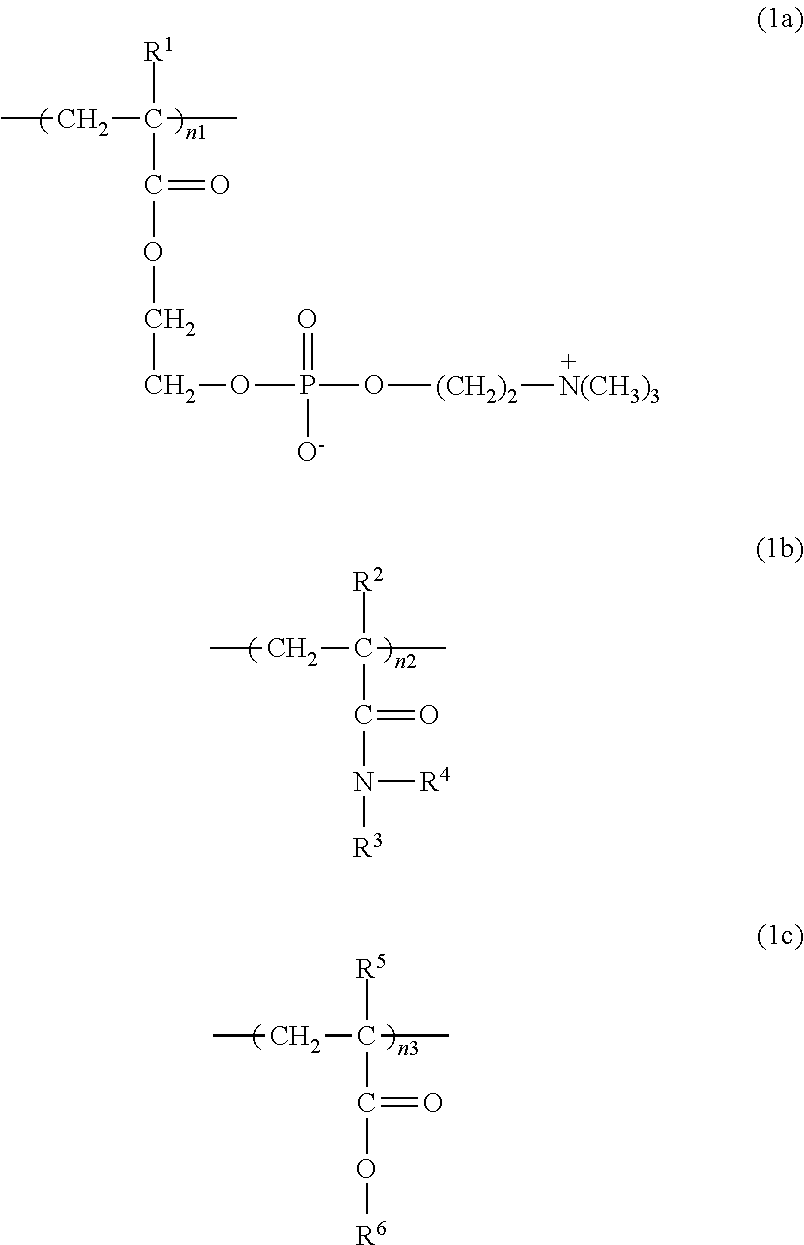Contact lens care preparation and packaging solution
a technology for contact lenses and preparations, applied in chemical instruments and processes, detergent compositions, chemicals, etc., can solve the problems of ineffective preparations, impaired wearing comfort, and insufficient improvement, and achieve the effects of durable surface lubricity and amebic adhesion inhibitory effect, simple treatment, and simple treatmen
- Summary
- Abstract
- Description
- Claims
- Application Information
AI Technical Summary
Benefits of technology
Problems solved by technology
Method used
Image
Examples
synthesis example 1-1
Polymer A-1; MPC 0.50—SMA 0.05—DMAA 0.45
[0076]31.75 g of MPC (manufactured by NOF CORPORATION), 3.64 g of stearyl methacrylate (SMA, manufactured by NOF CORPORATION), and 9.60 g of N, N-dimethylacrylamide (DMAA, manufactured by KOHJIN CO., LTD.) were dissolved in 55.0 g of ethanol, placed in a four-neck flask, and bubbled with nitrogen for 30 minutes. Then 0.10 g of PERBUTYL ND (trade name, manufactured by NOF CORPORATION, abbreviated as PB-ND hereinbelow) was added at 50° C., and polymerized for 8 hours. The resulting polymer solution was added dropwise into 3 liters of diethyl ether under stirring. The resulting precipitate was taken out by filtration, and vacuum-dried at room temperature for 48 hours to obtain 40.2 g of powder. The molecular weight determined by GPC was 1,000,000 in weight average molecular weight. This powder was designated as Polymer A-1. The IR, NMR, and elemental analysis data are as follows:
[0077]IRdata: 2964 cm−1 (—CH), 1733 cm−1(O—C═O), 1651 cm−1(N—C═O), 1...
synthesis example 1-2
Polymer A-2; MPC 0.30—SMA 0.03—DMAA 0.67
[0082]24.13 g of MPC, 2.77 g of SMA, and 18.11 g of DMAA were dissolved in 55.0 g of n-propanol, placed in a four-neck flask, and bubbled with nitrogen for 30 minutes. Then 0.10 g of PB-ND was added at 50° C., and polymerized for 8 hours. The resulting polymer solution was added dropwise into 3 liters of diethyl ether under stirring. The resulting precipitate was taken out by filtration, and vacuum-dried at room temperature for 48 hours to obtain 42.4 g of powder. The molecular weight determined by GPC was 1,2000,000 in weight average molecular weight. This powder was designated as Polymer A-2. The IR, NMR, and elemental analysis data are as follows:
[0083]IR data: 2964 cm−1 (—CH), 1733 cm−1(O—C═O), 1651 cm−1 (N—C═O), 1458 cm−1 (—CH), 1253 cm−1 (P═O), 1168 cm−1 (C—O—C), 997 cm−1 (P—O—C).
[0084]NMR data: 0.8-1.2 ppm (CH3—C—), 1.4 ppm (—CH2—), 3.3 ppm (—N(CH3)3), 2.8-3.2 ppm (—N—(CH3)2), 3.7-4.4 ppm (—CH2CH2—).
Elemental Analysis Data:
[0085]Theoret...
synthesis example 1-3
Polymer A-3; MPC 0.70—SMA 0.06—DMAA 0.24
[0088]32.96 g of MPC, 3.24 g of SMA, and 3.80 g of DMAA were dissolved in 60.0 g of n-propanol, placed in a four-neck flask, and bubbled with nitrogen for 30 minutes. Then 0.10 g of PB-ND was added at 50° C., and polymerized for 8 hours. The resulting polymer solution was added dropwise into 3 liters of diethyl ether under stirring. The resulting precipitate was taken out by filtration, and vacuum-dried at room temperature for 48 hours to obtain 36.1 g of powder. The molecular weight determined by GPC was 700,000 in weight average molecular weight. This powder was designated as Polymer A-3. The IR, NMR, and elemental analysis data are as follows:
[0089]IR data: 2964 cm−1 (—CH), 1733 cm−1 (O—C═O), 1651 cm−1 (N—C═O), 1458 cm−1 (—CH), 1253 cm−1 (P═O), 1168 cm−1 (C—O—C), 997 cm−1 (P—O—C).
[0090]NMR data: 0.8-1.2 ppm (CH3—C—), 1.4 ppm (—CH2—) 3.3 ppm (—N(CH3)3), 2.8-3.2 ppm (—N—(CH3)2), 3.7-4.4 ppm (—CH2CH2—).
Elemental Analysis Data:
[0091]Theoretical...
PUM
| Property | Measurement | Unit |
|---|---|---|
| molar ratio | aaaaa | aaaaa |
| molar ratio | aaaaa | aaaaa |
| molar ratio | aaaaa | aaaaa |
Abstract
Description
Claims
Application Information
 Login to View More
Login to View More - R&D
- Intellectual Property
- Life Sciences
- Materials
- Tech Scout
- Unparalleled Data Quality
- Higher Quality Content
- 60% Fewer Hallucinations
Browse by: Latest US Patents, China's latest patents, Technical Efficacy Thesaurus, Application Domain, Technology Topic, Popular Technical Reports.
© 2025 PatSnap. All rights reserved.Legal|Privacy policy|Modern Slavery Act Transparency Statement|Sitemap|About US| Contact US: help@patsnap.com



